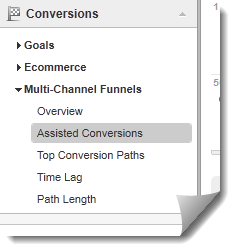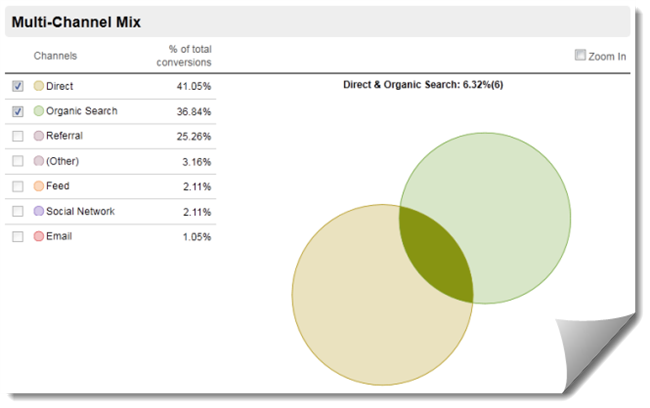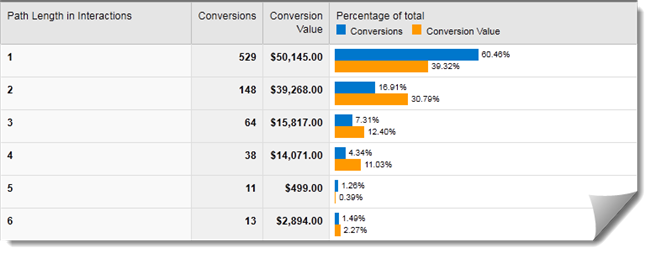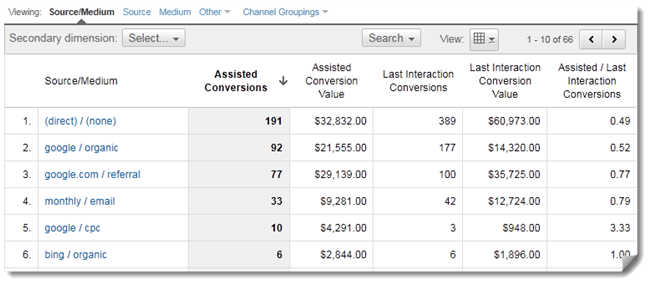Multi‑Channel Funnels In Google Analytics

Note: Google Analytics has let us know that the feature called Multi-Channel Funnels discussed in this blog post is in limited pilot. That means that Google Analytics is testing the feature and its usefulness to a small group of trusted testers, and have not made any plans or a timeline for a full launch.
Google Analytics is finally getting an upgrade to its outdated attribution model in the new Multi-Channel Funnels. Announced at Ad:Tech San Francisco last week, this new model will show how all of your various traffic sources are working together to create conversions on your site. This is without a doubt one of the coolest features to come down the Google Analytics product pipeline, and here’s why.
Most of us are used to dealing with last-click attribution. When a visitor to your site converts, your analytics tool gives credit to the last channel that brought them there. With Multi-Channel Funnels, we get a bigger picture. It’s similar to the Search Funnels features that AdWords launched last year, except now we get to see how all traffic–search, referral, whatever–interacts as your visitors move in and out of your site.
So join me as I take a look at some of the features of Google Analytics’ new Multi-Channel Funnels.
Are You Missing Part of the Story?
Bear in mind that these new reports are only available within the new Google Analytics interface. The good news is that everyone should have access to v5 by now. The bad news? You probably don’t have access to Multi-Channel Funnels. They’re still awesome and once you do have them, they’re gonna change your life. So bear with me.
Multi-Channel Funnels will show up as an option under the Conversions menu. The first report you’ll see is, of course, the Overview. I can almost guarantee that it’ll bring a smile to your face, because it’ll tell you something like:

Sure, it doesn’t really give me a lot of information, but it does tell me that, up until now, I’ve been missing out on important intelligence. Those Assisted Conversions? They tell me that I’ve got traffic hitting the site with one channel and then converting through another. That seems useful, right?
I gotta admit, I’m a sucker for Venn diagrams. The Multi-Channel Mix report on the Overview is really fun for seeing how your various channels interact with one another. Check off the sources to the left and see how they overlap in the diagram:

Move Beyond Last-Click Attribution
For the meat and potatoes, we’ll dig down into the Path Length report. Here you can see how many “interactions” with your site it takes before visitors convert.

Above, we can see that 40% of our conversions occurred after more than one channel interaction. Even cooler, we can see the percentage of conversion value. Over 60% of our conversion cash is attributed to two or more channel interactions. Is it important that we spend some time analyzing ways to get first-time visitors back to our site via other channels? The numbers don’t lie.
But how do we see which channels are best at up-front conversions and which excel at last-click? Well, you’d use the Assisted Conversions report:

The report defaults to the “Assist Interaction Analysis,” which shows us a list of our channels with the number of times they appeared in the conversion path but were not the final conversion interaction. This, compared with the number of times they were the final conversion interaction, hints at the channel’s role. Does it serve primarily as a way to eduacte your visitors about your product, or does it push them to convert? To use the obligatory basketball analogy, is it John Stockton or Michael Jordan?
Know Your Channels’ Roles
This new metric is currently called “Assisted/Last Interaction Conversions,” which, frankly, sucks. I like what Justin Cutroni calls it: the “Exposer to Closer Ratio”. It is, in a word, awesome. If there’s any better indicator of the contextual efficiency of your marketing channels, I don’t know what it is. Previously, if your social media referrals were showing a low conversion rate, you’d probably stop trying, right? Cancel the Twitter account and stop all the Facebooking? Now you can see that they’re just creating prospects who come back to the site via other means and ultimately convert.
If you change the view from Source/Medium to Default Traffic Groups, you get to see something that a lot of marketers have been clamoring for: Channel Grouping. I had a call this afternoon, in fact, where a client asked me how he could better organize his channels in Google Analytics. I told him the same thing I’ve told all my clients for the past five years: use filters. And then I sighed heavily into the phone.
Thankfully, it looks like those days will soon be over. By default, Google groups your channels into various buckets for you:

But here’s the best part: you can make your own! If you want to define your own groups, it’s as easy as setting up a new segment. It even uses a similar interface:

This is big news. One of the biggest complaints I’ve heard from others users is the inability to modify how Google Analytics presents its data after it’s been collected and run through filters. With customized groups, users are now free to change the information architecture of their reports even more than before. This is a very, very good thing.
For more information on the other Multi-Channel Funnels reports, check out the official help page from Google and the videos below:


